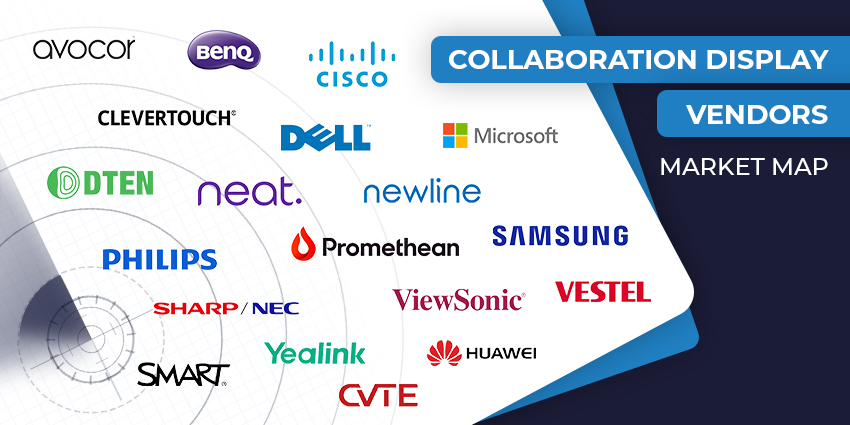If you’re like most enterprise leaders right now, you’ve probably noticed just how central meeting room technology has become to the way your teams work. The humble display has evolved far beyond being “just a screen.” Today, the best collaboration display vendors are giving companies interactive, intelligent hubs designed to bring people together on a deeper level.
The collaboration display market has exploded with new solutions: giant interactive touch screen boards that double as whiteboards, ultra-wide displays designed for more inclusive layouts, and built-in AI features that make sessions easier to join and manage.
If you’re ready to power up your meeting rooms, this guide introduces the top vendors taken from our collaboration display marketplace. Our goal is to help you understand the market, and see which solutions actually make a difference to productivity, user experience, and IT management.
The Top Collaboration Display Vendors
Collaboration Display Vendors: Devices That Dominate
The collaboration display market is busy, no doubt about it. Dozens of brands claim they’ve built the smartest screens for hybrid work. But only some collaboration display vendors are really making meetings simpler, more inclusive, and less painful to manage.
Some offer inclusive, interactive touch screen whiteboards, others are focused on AI features or ultra-wide formats that bring remote participants into the room. The good news? There’s a solution for just about every space, from small huddle rooms to the biggest boardrooms.
Avocor
Avocor has been building a name for itself among collaboration display vendors, and its latest boards show why. The E92 is a giant, 92 inches wide, with a 21:9 aspect ratio that gives everyone more room to work. The ultra-wide canvas makes video calls feel more natural, with space for content and remote participants side by side. Up to 50 touch points keep workshops interactive, whether you’re sketching, annotating, or pulling in multiple team members at once.
The company’s strength is how well its kit plays with others. Partnerships with Microsoft, Zoom, Logitech, Google, and Miro mean Avocor boards take minutes to set up. IT teams also get the benefit of FUSE, Avocor’s cloud management tool, which takes the pain out of monitoring and updating a fleet of displays.
Plus, if you’re looking for support, Avocor covers everything, from initial demos and planning, to ongoing technical assistance.
BenQ
BenQ has always been about no-nonsense displays, and that continues in its latest lineup. The RE04 Series sits firmly in the middle of the collaboration display market: accessible, Google-certified, and ready to use straight out of the box. Sizes run from 65 to 86 inches, with anti-glare 4K panels, antimicrobial glass, and TÜV-certified eye-care features. It’s built to survive heavy daily use, whether in a meeting room or a training space.
EZWrite 6 brings a canvas that never feels cramped, plus AI features like translation and OCR that make sessions easier to capture and share. InstaShare 2 handles wireless casting with touchback control, and native Google tools mean most teams can run workflows without connecting a laptop.
For business buyers, the RE04FV variant is the one to watch. With its built-in camera, microphones, and BYOM support, it drops neatly into a Teams or Zoom environment.
Cisco Webex
Cisco’s long track record in enterprise collaboration shows in the Board Pro G2. It’s a single device that rolls together a 4K interactive touch screen, dual cameras, microphone arrays, and an AI-driven compute core. The result is a board that’s as comfortable running a high-stakes executive briefing as it is hosting a hybrid brainstorm.
The intelligence comes from NVIDIA AI, which powers auto-framing, voice tracking, and noise reduction. That means remote participants don’t miss a thing, even in larger rooms. Compatibility is wide too: Webex, Microsoft Teams Rooms, Zoom, and apps like Miro all work natively.
From IT’s perspective, the Control Hub offers clear oversight across device health, analytics, and updates. Plus, Cisco offers an onboarding service with a use case library, expert videos and live sessions, and adoption support to boost return on investment.
Clevertouch
Clevertouch has its roots in education, but it’s been building a serious presence in the enterprise selection of collaboration display vendors. side of the collaboration display market. Its latest LUX for Enterprise 2 series is built on a Rockchip processor, launches with the slick new Lux 2 UI, and supports Wi-Fi 6E, making it fast and reliable.
You get Google EDLA certification and Clevershare included, so teams can use Google Play apps and collaborate without jumping through hoops. Clevertouch also centralizes control. Their “CleverLive” signage feature lets you push organization-wide messaging to idle screens. Flick your NFC badge and the screen loads your personalised profile.
There are plenty of alternative options available too, from ultra-robust solutions like the IMPACT Secure, to simple digital signage systems and even the “Stage” display, specially designed for collaborative workplaces.
CVTE
Technology innovators, CVTE produce all-in-one interactive displays for modern conferences. Solutions like the CVTE conference panel offer companies an all-in-one solution for communication, whiteboarding, and advertising signage. The technology is compatible with almost all the conferencing software available today and features wireless screen-sharing capabilities.
Teams can choose from a menu of sizes, from standard classroom panels to massive conference-capable digital signage and LED walls. The company also supports accessories like mobile trolleys and OPS modules for quick deployment.
The EA Series in particular earns solid marks as “an excellent choice” for organizations wanting dependable collaboration hardware that won’t break the bank.
Dell
Dell is one of the better-known names among collaboration display vendors, making smart strides with meeting space solutions. Its C Series Collaboration Monitors plug into its OptiPlex ecosystem, so you get pop-up cameras, built-in mics, speakers, and a lockable compartment for PCs, adding real polish to video-first workspaces.
The touch-enabled variants support 20-point touch, palm erase, and stylus input, making them legitimate interactive touch screens, not just video monitors. For IT, the RJ45 and RS-232 ports mean easy remote device management, so you can push updates or reboot displays across the office without a site visit.
Dell’s technologies prioritize user experience, with stunning visuals and “ComfortView” anti-glare and anti-smudge coatings to enhance readability. The company also offers a step-by-step onboarding experience and a secure deployment solution.
DTEN
DTEN’s offerings deliver straightforward, reliable collaboration for businesses of all sizes. The D7X All-in-One is built for enterprise rooms that need to get on the call and stay there. One USB‑C cable is all you need to plug in, and you’ve got your camera, mic, and speakers ready to roll. Zoom is baked in, and Teams is only a download away, so hybrid teams aren’t fumbling with software installs.
OS Flexibility is a selling point too, allowing companies to enjoy compatibility with both Android and Windows devices. Plus, many of DTEN’s solution come with AI included, such as the intelligent sound suppression systems that automatically filter out background noise.
For device management, DTEN also has “Orbit”, a user management platform with full insights into device health, usage, and firmware updates.
Huawei
Producing smartphones, displays, and other intuitive technology, Huawei is among a number of collaboration display vendors with a growing presence in the enterprise landscape. The company’s flagship interactive display, the IdeaHub, combines 4K and full HD video conferencing with a simple setup that eliminates the need for excess cables. It also comes with tap-to-join solutions for instant collaboration.
Huawei’s IdeaHub S2 brings your BYOM (Bring Your Own Meeting) dreams to life with Wi‑Fi 6 and near-zero latency writing, all backed by AI-driven camera auto-framing and crystal-clear mic arrays.
Beyond the tech specs, this board drives smarter meetings. Tap a “project” button on your phone (no network needed), and your screen loads instantly. A smart toolbar keeps your writing smooth; an AI camera keeps presenters in focus; ultra-long mic pickup means audio never drops off, no matter how big the room.
Microsoft
Popular UC and collaboration software vendor Microsoft also provides companies with various hardware solutions and displays through the “Surface” portfolio. The Surface Hub 3 is Microsoft’s headline in the collaboration display vendors arena. Built by Microsoft, for Microsoft, and everyone else, too, it comes in 50‑ and 85‑inch models.
Both are loaded with a 4K anti‑glare interactive touch screen, 20‑point touch (85-inch), dual pens, and a built-in Smart Camera with a 136° field-of-view. You get one-touch join for Teams, Zoom, or Webex, and AI features like speaker recognition, noise suppression, and optional Miracast support.
Orchestrated with Windows Teams Rooms and managed via Microsoft Intune and Teams Admin Center, deployment and security fall into familiar enterprise workflows: Autopilot, BitLocker, TPM, the whole kit.
Neat
Neat positions itself as a smart choice among collaboration display vendors, especially with its sleek Neat Board 50. This is a 50″ interactive touch screen that thinks fast. You get a 4K panel, anti-glare coating, and a silicon-rich active marker that draws and erases without pairing or charging fuss. Just snap it on and start sketching.
Where the Neat Board 50 really steals the show is its built-in intelligence. A 50MP wide-angle camera tracks every participant across a 113° field of view, and the five-array mic setup with noise suppression keeps audio crisp, even in lively spaces.
It’s also flexible. Whether you tether a second screen via HDMI or wheel it between rooms on the adaptive stand, this board stays put when you need mobility, and resets when you don’t. Two boards can link up, each hosting different apps for multitasking sessions.
Newline Interactive
Newline continues to push boundaries in the collaboration display market, especially with displays that behave more like teammates. The Lyra Pro is an exciting new addition, with multi-system compatibility, multi-touch support, and BYOD connectivity.
It recognizes fingers, pens, and palms, with built-in object recognition that knows when you’re drawing versus erasing. Add Merlyn AI into the mix, and you get voice control plus prompts for smarter workflows. Native Google integration means Workspace, Drive, and Classroom are all easy to access.
There’s even a Z Pro model with modular AI-driven cameras, mic arrays, and 4K visuals, handy for security-conscious boardrooms or creative spaces.
Philips
A well-known vendor in the technology world, Philips produces hardware for both consumers and businesses. The E‑Line collaboration displays are powerful, Android 13 native, with up to 50 touch points, and built tough with anti-glare, anti-reflective, and anti-fingerprint glass.
The OPS slot means you can embed a PC without adding cables, and with cloud-based PPDS Wave management you can batch-update, monitor health, and schedule it all centrally without leaving your desk. Phillips also offers an incredible range of interactive kiosks, booking displays, and video walls.
Philips understands this: when the display is a daily touchpoint for presentation, room booking, wayshowing, or team brainstorms, friction kills creativity. These boards are built to stay running, stay managed, and let people focus on ideas.
Promethean
Promethean has built its name answering the needs of educators, but they don’t leave enterprises out either. As one of the leading collaboration display vendors, Promethean delivers next-generation technology that combines user experience with security.
The ActivPanel 10 lineup is customizable, no‑nonsense, and built to last. You can pick Android, Windows, or Chrome OS, depending on what your IT team prefers, and the interface stays instantly familiar. Its touchscreen tech is solid too: optical or zero-bonded glass, QLED brightness, and crisp 4K resolution keep brainstorming sessions clear. Pens don’t ghost, touch feels precise, and the slimmed-down UI means people spend more time drawing and less time fumbling through menus.
The ActivSuite lets users take panels with them, annotations, tools, templates, whether they’re at the board or remote. It doesn’t feel licensed or locked down. Plus, most displays immediately pair with UC platforms.
Samsung
Global technology vendor Samsung produces a variety of interactive display options for customer engagement, entertainment, and enterprise collaboration. The organization’s portfolio of products comes with industry-leading features, such as anti-glare coatings for comfort, embedded media players, and dust-resistant components.
Touch is as smooth as you’d expect with low-latency response, and stylus-friendly screens that feel intuitive from the first tap. The displays stream wirelessly and are ready for both whiteboarding and signage, without having to load extra apps.
Samsung also brings reliability to the table. Their panels are ruggedized with antimicrobial coatings and built to run 16 hours a day including weekends, great for hybrid offices where the display never really sleeps.
Sharp/NEC
Combining sustainable technology with user experience, Sharp/NEC produces interactive display solutions for businesses, educational groups, and more. The organization’s screens can support single or dual-touch functionality and come in a range of sizes, from 43 to 98 inches, to suit the style and design of your meeting or conference room.
In the more collaboration-focused line, you’ll find the CB651Q, a 65″ all-in-one panel with Mosaic whiteboarding, wireless presenting, and a built-in SoC. It’s loaded with connectivity, from HDMI 2.0 ports to an OPS slot, meaning you can scale features as your tech matures.
The collaboration portfolio covers Android models, secure Intel SoC boards, and legacy command support. Plus, every device is built for durability, security, and interactive ease.
SMART
SMART still commands attention among interactive display vendors, with its well-known family of SMART Board products. The latest Enterprise Series which includes the SBID-7000 Pro and SPNL-6000 Pro, delivers polished visuals (4K UHD, crisp contrast), robust build (heat-tempered glass, 50,000-hour LED life), and all the connectivity you’d need: HDMI, DisplayPort, USB, OPS slots, and RS‑232 for deeper manageability.
These displays are built to last, ENERGY STAR certified, sturdy frames, and intuitive screens mean fewer service tickets and more uptime. Touch experience is solid, too: HyPr Touch or DViT tech keeps multi-finger gestures accurate and fast.
What sets SMART apart is how it treats displays as active workspaces, not just screens. Object awareness, natural touch gestures, and even presence detection make interaction feel second nature, and the enterprise-friendly support plans are great for growing teams.
Vestel
Vestel is beginning to play a big part in enterprise collaboration. The company’s cloud-based dynamic series of interactive flat panels come in 65″, 75″, and 86″ sizes, with Android 13 baked in and quick touch response for daily use.
These screens run full Windows desktop environments and support native video conferencing apps like Teams and Zoom, especially when paired with a USB camera. On the apps side, you even get cloud-assisted live translation of presentations for global teams.
Vestel screens are built for regular use. They feature OPS slots, Intel vPro hardware, and are designed as long-running endpoints in environments that demand stability and flexibility. They also come with an anti-glare surface, to improve user experience, and companies can also enhance their ecosystem with a range of accessories and mounting options.
Viewsonic
ViewSonic’s ViewBoards bring serious collaboration horsepower to teams, especially with their Gen 5 and ultrawide models. For instance, the IFP105UW is a massive 105″ display with 5K resolution, 40-point touch, octa-core performance, Wi‑Fi 6, and Teams Rooms compatibility.
The IFPUW Series ups the game too, with a 21:9 aspect ratio 5K board designed for Teams Rooms Front Row layouts. With 50-point touch, dual USB‑C, 8-mic arrays, and powerful speakers, it handles both collaboration and presentation seamlessly.
Companies can also leverage built-in software to wirelessly share content with their screens or access wired connectivity through HDMI and USB-C. There’s also a simple remote management system included with Viewsonic’s technologies, allowing companies to track and manage over-the-air updates from a central location.
Yealink
Yealink leans into simplicity, building displays that work seamlessly, and that starts with their MeetingBoard Pro line. These all-in-one interactive touch screen boards bundle video conferencing, display, and whiteboarding into one unit.
Yealink MeetingBoard 65 address the needs of collaborative teams with built-in premium AI audio-video capabilities. They can also adapt to all meeting room sizes and integrate with your existing hardware. Their 75″ Pro variant steps it up: 4K visuals, triple ultra-wide cameras, AI-driven speaker tracking, and mics that work up to 12 meters away.
Plus, these devices run Teams and Zoom natively. Yealink also offers dedicated interactive displays for individual users and focus rooms, like the DeskVision A24. This solution features built-in audio and video, a peripheral mode option, UC workstation integration, and touch input functionality.
Finding the Right Fit Among Collaboration Display Vendors
There’s no single answer when it comes to collaboration display vendors. Every company has its quirks. A legal firm running Teams all day might prioritise security and compliance tools. A design studio might care more about pen response on a huge interactive touch screen. Some IT leaders just want something that boots quickly and doesn’t break down.
That’s why the collaboration display market is so interesting right now. We’ve moved past the era where these boards were clunky, confusing, or too niche. Today’s vendors have learned their lessons. The latest devices are faster, sleeker, and play well with the UC platforms most teams already rely on.
If you need help making the right choice, UC Today has the resources to guide you:
- Discover exclusive data: Our research reports highlight what’s changing in 2025, who’s leading, and why.
- Talk to peers: The UC Community is packed with leaders, strategists, and collaboration champions who’ve been where you are.
- See it up close: At upcoming industry events you’ll meet vendors, test the tech, and swap notes with others solving the same challenges.
- Get the guide – The Ultimate UC Buyer’s Guide takes you through the whole process, from first requirements to rollout.
The right collaboration display vendors don’t just upgrade a meeting room. They change the way teams connect, share, and get real work done.







